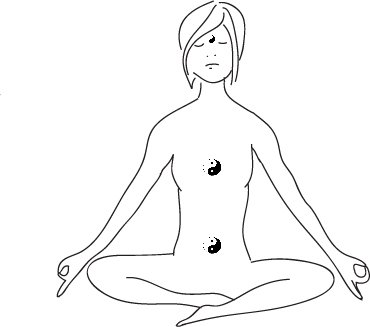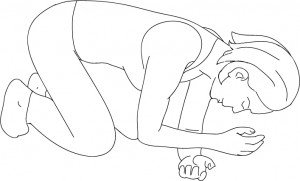Happy Body — Do-In
by Lilian Kluivers
Do-In, a form of Dao Yin that is further developed in Japan, is a system of exercises that promotes our energy flow. Do-In combines meridian stretching with meditative techniques, chi strengthening exercises and acupressure. This article describes a short sequence that paves the path to happiness.
 Remember that evening when you were sitting outside, a cup of tea warming your hand, watching the sky, feeling the soft wind gently stroking your skin.The moment when you took a deep breath and had the feeling that everything is just perfect right now.
Remember that evening when you were sitting outside, a cup of tea warming your hand, watching the sky, feeling the soft wind gently stroking your skin.The moment when you took a deep breath and had the feeling that everything is just perfect right now.
Happiness is not something we can achieve by following a certain ‘to do-list.’ Actually, happiness is more the feeling that we experience at moments we are not trying to achieve anything. It is something that happens to us when we are completely here and now, accepting and enjoying this moment.
So, to experience happiness (even) more often, exercises to arrive ‘here and now’ are vital. Examples of such exercises are meditation and ones that balance our chi.
Looking at ourselves in terms of chi makes us understand that when we are distracted, this can often be seen as a blockage. Especially when we live, so to say, in the past or future. It takes chi, blood, and might even take jing, if someone is not able to let go and get in touch with this moment.
Even when this particular moment isn’t so great at all, getting in touch with it by resolving blockages that kept us trapped in time is an important first step. So how to get there?
Below you can find a series of Do-In exercises. They are easy, effective and can be used by anyone, whether you are a professional working with chi or not. In fact they are so easy that as a therapist you can teach them to your clients so they can work on their energy balance themselves in between the treatments. Always remember to be gentle to your body. Exercises should never hurt, so take responsibility for your body by listening to the signs it gives you.
1. Aligning the dantians (energy centers).
Take a sitting posture. Any posture with a straight back is fine. Place your hands on your knees, or if you like, make a mudra with you fingers. Place for example your thumb on the side of your index finger on the acupressure point Large Intestine 1 to promote letting go of that which no longer serves you.
Bring your attention to your head. What do you notice? A lot of thoughts? Maybe even a vibration when it is very busy in your head? And whatever it is you notice, try to get in touch with the stillness, the peaceful quietness that is always present behind your thoughts. Stay there for a minute.
Now bring your attention to your heart. How does your heart feel? And try to get in touch with the warm and happy sensation that is always there, somewhere in your heart. Let it shine and grow. Maybe even smile to your heart.
Now bring your attention to your lower belly, right below your navel center. Feel the energy in this lower dantian (tan den in Japanese) or energy center. The energy wells out from this center and spreads through your body much like a fountain does. Feel yourself becoming heavy and grounded. And feel the breath flowing all the way towards your lower belly. Continue breathing deeply and slowly just like this through the next exercises.
2. Opening the governing vessel, Du Mai
Start this exercise by sitting on the floor. Hold your lower legs right below your knees. (If you are familiar with acupressure points: hold Stomach 36). Make a round spine and gently roll back to your shoulderblades, and forth sitting straight up. Repeat this twenty to fifty times. 
When this exercise feels awkward just lie on your back and massage the meridians by swinging from left to right.
3. Opening the joints
Remember the lower dantian we just activated in the first exercise? Try to feel this area again. Let the movement for this next exercise start in this dantian.
Get down on your hands and knees. Curl your toes to the floor. Start to playfully circle around your hands and knees. Feel that in this movement you massage almost all the joints: hands, shoulders, spine, neck, knees, hips, and toes. After about a minute change direction.
4. Regulating Heart protector and Yang Linking Vessel
This next exercise is an acupressure technique. Lean on your lower arms. Turn one palm facing up, intuitively decide which one. With the pinky side of the other arm, start leaning into this first arm, starting from the elbow. With every inhalation lift your arm and place it a bit closer to your wrist. With every exhalation lean.
Stay a bit longer leaning at the spot two cun (thumb widths) from the increase in your wrist. This is an acupressure point, Heart Protector 6, regulating one of the curious vessels called Yin Linking Vessel. This vessel is often blocked when experiences from the past tend to take too much of your energy.
With your elbow, lean into the center of your hand palm, also a strong acupressure point working on the emotional energy.
Treat your other lower arm in the same way.
5. Regulating Triple Heater and Yang Linking Vessel
This exercise is quite similar to the previous one. The difference is that you should turn the hand of the arm you’d like to treat with the palm facing down.
Again use the other arm to give shiatsu, now to the outside of your arm.
Also this time pay special attention to the acupressure point two cun from the increase in your wrist. This is an acupressure point, Triple Heater 5, regulating the curious vessel called Yang Linking Vessel. This vessel is often blocked when plans for the future tend to take too much of your energy.
You don’t have to lean on the back of your hands, stroke from the wrist towards your energy.
6. Stretching the Heart Meridian
Now take a cross legged position, or if possible take an even exaggerated cross legged position – as I like to call it. Bring the left foot to your right hip, cross the right leg over this left leg and bring the foot towards your left hip. Your knees should be right above each other.
Straighten your right arm up, bend the elbow so that the hand is in between your shoulder blades. Be careful with your neck, keep it straight up.
With your left hand, help the right elbow towards the middle and back so that you feel a nice stretch from the right armpit towards the right elbow, the Heart Meridian.
If possible, bend your left arm down and backwards and interlace fingers at your back.
Breath slow and deep, change sides after five breaths.
It is possible that the stretch feels totally different on the other side, and this is a sign that the energy is not evenly divided.
7. Smile meditation
End this sequence by taking a nice sitting posture. Any posture is fine, as long as you are able to keep your spine straight. Make space between the vertebrae.
Close your eyes, soften your face and place the tip of your tongue behind your front teeth on the pallet. Focus your attention to your breathing, take deep inhalations; the lower belly should raise. Exhalations are long and slow.
 Now start smiling to yourself.
Now start smiling to yourself.
Smile towards your lower dantian and the area around it, bladder, kidneys, intestines etc…
Smile towards the middle dantian and the area around it, heart, longs…
Smile towards your upper dantian, brains…
Feel your whole body and spread positive energy through it with every exhalation.
Finish the exercises by bending forward, a sign of gratitude.
 Lilian Kluivers is a shiatsu therapist and Do-In teacher and teacher trainer. She runs Do-In Academy, an international education that aims to help people use the wisdom of eastern medicine in everyday life. Lilian is an author of two books about Do-In published in The Netherlands and Belgium.
Lilian Kluivers is a shiatsu therapist and Do-In teacher and teacher trainer. She runs Do-In Academy, an international education that aims to help people use the wisdom of eastern medicine in everyday life. Lilian is an author of two books about Do-In published in The Netherlands and Belgium.

